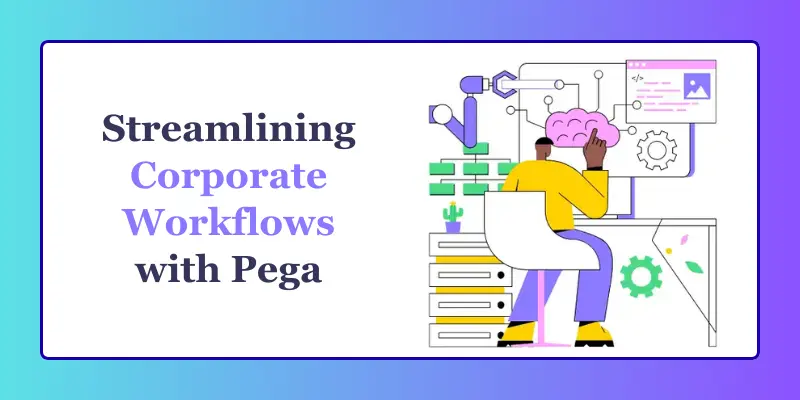Organizations need efficient workflow management solutions to stay competitive in today’s fast-paced corporate world. Pega, a powerful Business Process Management (BPM) tool, helps businesses automate, optimize, and streamline their workflows. By reducing manual tasks and enhancing collaboration, Pega enables companies to improve efficiency and achieve operational excellence. Pega Training in Chennai equips professionals with the skills to leverage this platform effectively. This blog explores how businesses can use Pega to streamline corporate workflows effectively.
Understanding Pega and Its Capabilities
Pega is a low-code automation platform designed to help organizations improve their business processes. It offers AI-driven decision-making, robotic process automation (RPA), case management, and seamless integration with existing enterprise systems. These capabilities make it a powerful tool for automating repetitive tasks and ensuring smooth workflow execution.
Key benefits of using Pega include:
- Automation of Routine Tasks: Eliminates manual interventions, reducing errors and saving time.
- Improved Compliance: Ensures that workflows align with industry standards and regulatory requirements.
- Better Collaboration: Enables teams to work efficiently with real-time insights and process transparency.
- Scalability: Supports growing businesses by adapting to changing needs and increased workloads.
Steps to Streamline Corporate Workflows with Pega
1. Identify Workflow Bottlenecks
Before implementing Pega, organizations need to assess their current workflows and identify bottlenecks. Common issues include redundant processes, excessive manual interventions, and department communication gaps. Pega is perfect for digital transformation, enabling businesses to streamline operations and improve efficiency. By analyzing workflow inefficiencies, businesses can determine where automation can add the most value.
2. Design Workflow Automation with Pega
Once bottlenecks are identified, organizations can design automated workflows using Pega’s low-code interface. Pega’s drag-and-drop tools allow business users to create workflows without extensive coding knowledge. The platform provides pre-built templates and customizable workflow components that help accelerate development.
For example, a customer service workflow can be automated by integrating Pega’s AI-driven chatbot to handle common queries, reducing the workload on support teams and improving response times. Career Growth with Pega Certification can further enhance your expertise in such automation, making you a valuable asset in the industry and opening doors to advanced career opportunities.
3. Integrate Pega with Enterprise Systems
To maximize efficiency, Pega should be integrated with other enterprise systems such as CRM, ERP, and HR management tools. Pega’s API-driven approach allows seamless integration with third-party applications, ensuring smooth data flow across various departments.
For instance, integrating Pega with a company’s HR system can automate employee onboarding processes, reducing paperwork and improving the overall onboarding experience. Pega Impact on Employee Onboarding in HR is significant, as it streamlines workflows, ensures compliance, and enhances efficiency, making the onboarding process smoother for both HR teams and new employees.
4. Implement AI and Decision Automation
Pega’s AI-powered decision automation enhances workflows by making data-driven decisions in real time. Businesses can configure decision rules based on customer behavior, transaction history, or risk analysis to automate approvals, recommendations, and escalations.
For example, a financial institution can use Pega’s AI to assess loan applications and automatically approve or reject requests based on predefined credit risk parameters.
5. Leverage Robotic Process Automation (RPA)
Pega’s RPA capabilities help businesses automate repetitive tasks such as data entry, report generation, and document processing. By deploying RPA bots, organizations can free up employees to focus on high-value activities, improving productivity and reducing operational costs.
For instance, an insurance company can use Pega RPA to automate claims processing, minimizing manual errors and accelerating claim approvals. Pega Security Features for Enterprise Apps ensure that sensitive customer data remains protected throughout the automation process, providing a secure and efficient claims management system.
6. Monitor and Optimize Workflows
Pega provides real-time workflow analytics and dashboards that help businesses track process efficiency and identify areas for improvement. Organizations can set Key Performance Indicators (KPIs) to measure workflow performance and make data-driven optimizations.
For example, a retail company can monitor its order fulfillment workflow in Pega and identify delays in processing, enabling proactive resolution and improved customer satisfaction. The Uses of PRPC in such scenarios include streamlining workflow automation, enhancing real-time tracking, and ensuring efficient order management for better operational performance.
Case Study: How Pega Helped a Multinational Corporation
A global telecommunications company faced challenges in handling customer service requests due to inefficient workflows and high manual intervention. By implementing Pega’s BPM and AI-driven automation, the company achieved:
- 50% reduction in customer request processing time
- Improved case resolution rates by 40%
- Enhanced customer satisfaction scores
Pega’s automation capabilities streamlined the company’s service request handling, reduced operational costs, and improved overall efficiency.
Pega is a powerful platform that enables organizations to streamline corporate workflows, automate routine tasks, and improve decision-making through AI and RPA. By integrating Pega with enterprise systems, designing automated workflows, and continuously optimizing processes, businesses can enhance efficiency, reduce costs, and improve overall operational performance. Corporate Training in Chennai equips professionals with the skills to implement Pega effectively and drive business success.
As more companies embrace digital transformation, investing in Pega training and implementation will be a strategic move for organizations looking to stay ahead in the competitive market. If your business aims to optimize workflow efficiency, Pega is the solution to drive automation and innovation.
Also Read: How can GST Consultants Improve Their Cyber Security?
Comments
0 comments

